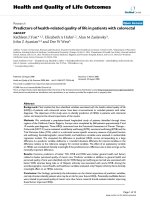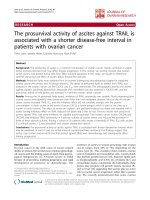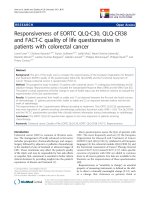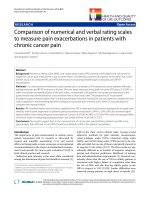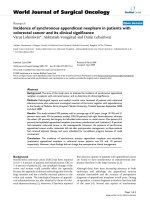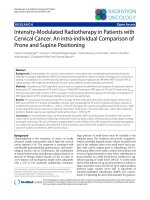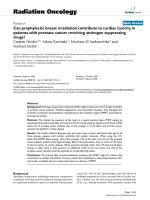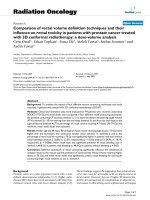Differences between asians caucasians in chemotherapeutic related outcomes in patients with colorectal cancer
Bạn đang xem bản rút gọn của tài liệu. Xem và tải ngay bản đầy đủ của tài liệu tại đây (702.35 KB, 113 trang )
DIFFERENCES BETWEEN ASIANS & CAUCASIANS IN
CHEMOTHERAPEUTIC RELATED OUTCOMES IN
PATIENTS WITH COLORECTAL CANCER
DARREN CHUA HSIANG LIM
NATIONAL UNIVERSITY OF SINGAPORE
2007
DIFFERENCES BETWEEN ASIANS & CAUCASIANSIN
CHEMOTHERAPEUTIC RELATED OUTCOMES IN
PATIENTS WITH COLORECTAL CANCER
DARREN CHUA HSIANG LIM
(M.B.B.S., NUS)
A THESIS SUBMISSION
FOR THE DEGREE OF MASTERS OF SCIENCE
SCHOOL OF MEDICINE
NATIONAL UNIVERSITY OF SINGAPORE
For He that is mighty hath done to me great things; and holy is
His name. – Luke 1:49 (KJV)
Acknowledgements:
Dr Richie Soong
Prof Chia Kee Seng
Dr Manuel Salto
Dr Tai Bee Choo
Dr Ross Soo
Mr Chen Ju
Ms Liew Li Lian
Ms Tan Wen Lee
Ms Jules Rusli
Ms Penny Tan Yi Hui
Ms Kathryn Li Wei Qi
Translational Interface, ORI
Center of Molecular Epidemiology, NUS Singapore
Molecular Histopathology, NUH Singapore
Department of Pathology, NUH Singapore
Department of Haematology and Oncology, NUH Singapore
School of Computing, NUS Singapore
Contents of Amendments
We thank the reviewers for his/her time in reading and commenting on the thesis. Below
are the contents of clarifications and amendments made to the thesis in light of the
comments.
1. Reviewer 1
2. Reviewer 2
3. Amended manuscript – Implications of variability in the distribution of
chemoresponse genotypes between Asians and Caucasians in colorectal cancer
4. Amended
manuscript
–
Meta-analysis
of
clinical
fluoropyrimidine chemotherapy in Asians and Caucasians
outcomes
from
Differences between Asians and Caucasians in chemotherapeutic related outcomes
in patients with colorectal cancer
REVIEWER 1 - (comments in bold and italics are made by candidate)
General comments
This thesis comprises two parts. The first is a review of the literature on genetic
polymorphisms linked with toxicity and response to chemotherapeutic agents commonly
used in colorectal cancer, with a focus on differences between Caucasian and Asian
populations. The second is a meta-analysis of phase II studies involving
fluoropyrimidines among colorectal cancer patients, the outcome of interest being
occurrence of three defined side-effects and response/survival rates. The primary
hypothesis is that racial differences that have been observed in the literature can be
predicted by prevalence of genetic variants which predispose to these outcomes.
I would suggest that the literature review should not be limited in scope to the genetic
factors, because this reduces its usefulness as an adequate basis for the meta-analysis
which forms the substantive component of this thesis. Specifically, if it is widely
accepted (‘dogma’ is the term used on page 63) that response and survival are more
dependent on tumour features than host genetic makeup, than an understanding of the
role of non-genetic determinants is critical for the proper appreciation of the field. These
points are alluded to in the brief discussion on page 27-28, but deserve more attention.
As was pointed out in the discussion pages of “Implications of variability in the
distribution of chemoresponse genotypes between Asians and Caucasians in colorectal
cancer”, non-genetic factors were considered. In fact, we have duly noted that “... such
differences may be prevalent outside of genetics as well.” (pg 39, para 1, line 4). We
did not expand on these points for we felt it may distract the readers from the main
points that we were trying to convey; which were that variability in the distribution of
chemoresponse genotypes between Asians and Caucasians in colorectal cancer may
result in different outcome. We believed it would make sense to investigate genetic first
before phenotypic (somatic mutation and non-inherited) variability, as phenotypic
variability has more confounders. When we considered phenotypic variability we
realized it would be quite considerable, and better discussed in a future additional
composition
A second general comment relates to the conduct of the meta-analysis. This may indeed
be an appropriate tool to answer this research question. However, it is important that the
candidate demonstrates a thorough understanding of the uses and limitations of this
design. There should be an attempt to search out and grasp the issues involved in
conducting the primary studies, beyond the numerical results, because these issues
influence the interpretation of the findings in the meta-analysis. The present study lacks
depth, and critical portion of the analysis are missing (see below).
I thank the reviewer for his/her comments which were very useful. We appreciate that
the reviewer agrees that the tool which we have chosen was the appropriate one as well.
In the light of the comments made above, several amendments and added data were
incorporated. Please read these in the “Specific comments” section.
In summary, I would suggest that this is a promising piece of work, but the scope and
depth needs to be extended.
Specific comments
Part 1
A large number of studies were identified from the publication literature. At certain
points, however, the referencing appears to be incomplete. These include the studies
given in the tables (e.g. Table 6, the first 2 studies cited are not in the reference list),
some figures (figures 2 and 3 are not referenced), and portions of the text (e.g. page 14,
para 2 and 3). Of the five articles cited in the discussion (page 27-8), only one (Iacopetta
2002) is found in the list of references (in which it is listed as a 2001 article).
I apologize for the incomplete referencing. Amendments have been made to correct
these. These include the addition of the two studies listed in Table 6 (Lin WY et al,
Toffoli G et al, etc), portions of text on (new) pg 25 (Soong R et al) and other citations.
Other citations that were left out previously but have since been included are: Rossit
AR et al (2002), Marsh S et al (1999) etc.
On the whole, the discussion is rather brief, and the last 2 paragraphs appears to be
related to specific agents rather than serving to summarize and conclude the section.
I thank the reviewer of his/her comments. Accordingly a summary section has been
added at the end of the discussion:
“In summary, we have identified a large number of published literature which shows
the association (even causal pathways) between genetic polymorphisms with toxicity
and response to chemotherapeutic agents commonly used in CRC, with the primary
focus on differences between Asian and Caucasian populations. Perhaps it will not be
too far off before personalized medicine becomes a reality, bringing with it better
treatment outcomes.” (pg 41, para 1)
Part II
The candidate has made a good attempt to bring together the findings of many studies,
and has chosen an appropriate tool.
For a meta-analysis to be of publishable quality, it should include a detailed description
of the exact search terms and a flow chart showing, in a step-wise fashion, how studies
were selected for inclusion. The key definitions (e.g. definitions of ‘response’ used in the
various studies, and any variations between studies) should be made clear.
As suggested, a flow-chart (new figure 1) showing, in step-wise, fashion how studies
were selected for inclusion was shown. Exact search terms were also shown. Key
definitions were discussed in the ‘Materials and Methods’ section:
“The common toxicity criteria (CTC) differs somewhat between the WHO, ECOG and
NCI grading scale. Even within the NCI grading system, there are different versions
depending on the publication date of the descriptive terminology that can be utilized for
Adverse Events (AE). For our meta-analysis, we have decided to term all Grade 3
toxicity and above as severe AE. Hence depending on the different criteria (CTC) being
used, there may be slight nuances. For example, comparing diarrhea, severe toxicity
(grade 3 and above) may include NCI (CTC ver 3) which includes >7 loose stools/day
and death (grade5), NCI (CTC ver 1) which includes 7-9 loose stools/day, and WHO >7
loose stools/day (no death). It was unfortunate we were not able to obtain the raw data
to stratify the analysis accordingly.
In general, the key definitions of response used in the various studies were similar
between the various studies. Completed response (CR) was defined as disappearance of
all objective evidence of disease lasting for more than 4 weeks. Partial response (PR)
was defined as a decrease of 50% or greater than 50% in the measurable lesion lasting
for more than 4 week. Progressive disease (PD) was defined was defined as an increase
of 25% or greater than 25% in the measurable lesion lasting for more than 4 week. All
other patients are considered to have stable disease”. (pg 87 para 2-3).
The funnel plot is also essential. In this case, it is mentioned in the methods but not
included in the results.
A funnel plot has now been drawn in the results section (new figure 2).
The Forest Plots (figures 1-4) are incomplete. The point estimates and confidence
intervals for the Asian studies are missing in all figures.
Printing issue – now addressed. The new forest plots can be seen in figure 3-7
There is no attempt to examine the sources of heterogeneity. The latter is a statistical
concept – while the reasons behind this are important in interpreting the results of the
meta-analysis. Without an understanding of why the studies could be heterogeneous, it is
not possible to state how meaningful the final summary estimates is and whether there is
a need to further stratify the studies (e.g. by patient or tumour characteristics).
Among the limitations mentioned in the discussion: two points stand out:
(1) The criteria for toxicity are not standardized between studies and
(2) Phase II trials had to be used because of the lack of phase III trials in Asian
populations, although the latter would have been more appropriate
While it is commendable that these limitations are recognised, it is not sufficient
to state them in passing. There should be an effort to examine what impact these
limitations have on the study and what steps can be taken to interpret the results in
the most valid way possible, given the constraints. E.g. by stratifying the analysis,
or using sensitivity analysis.
I thank the reviewer for his/her advice. Accordingly, a discussion of the sources of
heterogeneity was included in the ‘Discussion’ section. This can be seen in pg 94, para
2 and pg 97, para 3-5
Pg 94, para 2 – “In this paper, it is possible that sources of heterogeneity may have
been introduced by characteristic of the design and conduct of the studies. Even then, it
may often be difficult to explain heterogeneity. For example, (Owen et al., 2003)
carried out a review of the effect of breast feeding in infancy on blood pressure in later
life. Although there was clear heterogeneity, the authors were unable to explain it. The
obvious candidate explanatory variable, the age at which the blood pressure was
measured, was unable to explain the heterogeneity. Under these circumstances, the
authors accept the existence of the heterogeneity and say that the greater uncertainty
that this adds to their estimate should be reflected in the method of estimation and
calculation of the confidence interval. For our study, we did this using a random
effects model, where we regard each study as estimating a different effect.”
Pg 97, para 3-5 - “Significant analysis was also spent on heterogeneity. Our approach
to understanding heterogeneity in our data is to include a wide range of studies, but
then examine the sensitivity of the results by looking at more narrowly drawn subsets
of the studies.
Different data sets resulted in different nuances. For example, Yeh et al defined CR as
disappearance of all objective evidence of disease, including all necessary imaging
studies, lasting for more than 4 weeks. On the other hand, Cure et al defined CR as
disappearance of all signs and symptoms lasting for more than 9 weeks. The grading of
toxicity is also potentially skewed, coming from reports using a mixture of WHO and
NCI toxicity criteria. Such differences may also result in a source of heterogeneity in
the results.
In meta-analysis, when the differences in results between studies is greater than would
be expected by chance, we may need to investigate whether the observed variation in
Comment [RS1]: according to who?
results across studies is associated with clinical and/or methodological differences
between studies. In fact, an uncritical use of the technique can be very misleading. Hence,
exploring the possible reasons for heterogeneity between studies is an important aspect
in conducting a meta-analysis.”
Also in the ‘Discussion’ section, a thorough discourse on the limitations on our study
was done. These were an emphasis on how sensitivity analysis can further strengthen
our analysis, although it should be said that we have actually performed some form of
sensitivity analysis using our original analysis (i.e. by stratification). This can be seen
in pg 98, para 2-3:
“It is widely accepted that the robustness of a meta-analysis be examined in a thorough
sensitivity analysis. In many ways, we conducted our sensitivity analysis by calculating
the overall effect size in toxicity, response and survival. We then stratified this effect
size into ‘Asian’ and ‘Caucasian’ groups. Other more conventional methods that could
have been performed include applying the meta-analytic approach to subsets of the K
studies, and/or applying the leave-one-out method. Other than invoke the leave-one-out
method, other methods may also include a sensitivity analysis by applying the metaanalysis to subsets of studies based on high-quality versus low-quality studies.
We did not conduct any further subgroup analysis since the primary study was an
assessment between Asians and Caucasians.”
Differences between Asians and Caucasians in chemotherapeutic related outcomes
in patients with colorectal cancer
REVIEWER 2 - (comments in bold and italics are made by candidate)
This is a literature review of interethnic variability between Asian patients and Caucasian
patients in association with chemotherapy treatment, and exploration of possible genetic
variants that could explain these interethnic differences. The thesis is written up in 2
sections, the first dealing with the genotype of candidate genes that was associated with
chemotherapy for colorectal cancer. The second part goes into actual details on the
differences in pharmacodynamics of chemotherapy for colorectal cancer between the
Asian and the Caucasian populations. In general, the language is good, and easy to
understand.
Comments:
1. In the introduction, these should be discussion on why genotype was discussed
first, followed by phenotypes because obviously more logically the phenotype
could be discussed first, followed by an explanation on the basis of genotype.
I agree with the reviewer that it would make for better logic if phenotype was
explained, followed by genotype. However, as was pointed out in the discussion
pages of “Implications of variability in the distribution of chemoresponse
genotypes between Asians and Caucasians in colorectal cancer”, non-genetic
factors were considered. In fact, we have duly noted that “... such differences
may be prevalent outside of genetics as well.” (pg 39, 1 para, line 4). We did not
expand on these points for we felt it may distract the readers from the main
points that we were trying to convey; which were that variability in the
distribution of chemoresponse genotypes between Asians and Caucasians in
colorectal cancer may result in different outcome. We believed it would make
sense to investigate genetic first before phenotypic (somatic mutation and noninherited) variability, as phenotypic variability has more confounders. When we
considered phenotypic variability we realized it would be quite considerable,
and better discussed in a future additional composition
2. Given ethnicity is the main focus of the review, it would definitely help to
define the populations that are being studied. How homogenous are the
populations, ie when we speak of Asians, it could range from Southern China,
Japan, to Northern India, which encompasses a large population of
heterogeneous ethnogeography.
For this thesis, ethnicity was defined by geography. We have now added
clarifying text in the methods on what countries were considered (see Table 1 –
pg 110 and pg 86, para 1). Our data supports this grouping which shows that
Asians tend to have a more homogeneous toxicity profile and hence the
classification of Asians appears valid.
3. In the analysis of genetic variants that can affect irinotecan metabolism, it is
worth mentioning that there is interethnic variability in the bilirubin levels, and
that UGT1A1*6 polymorphism is the main polymorphism in Chinese and
Japanese.
I thank the reviewer for highlighting an important aspect of this review. Added
material in the Irinotecan section have been added to address the reviewer’s
concern. This is shown on pg 33 para 1:
“In patients homozygous for UGT1A1*6 (compared with the reference group), it
has been reported that the mean absolute neutrophil count was 85% lower and
the prevalence of grade 4 neutropenia was 27% (Jada SR et al 2007).
Furthermore, the presence of the UGT1A1*6 allele was associated with an
approximately 3-fold increased risk of developing severe grade 4 neutropenia
compared with the reference genotype group. These exploratory findings suggest
that homozygosity for UGT1A1*6 allele may be associated with altered SN-38
disposition and may increase the risk of severe neutropenia in Asian cancer
patients, particularly in the Chinese cancer patients who comprised 80% (n = 36)
of the patient population in their study.”
4. In the second analysis, it should be noted in there are non-genetic reasons for
interethnic variability of drug response and some of these reasons could be
mentioned. For example, the administration of 5-fluorouracil may not have
been standardized across all studies, and with differing durations of infusion,
this may affect the effects of 5FU as it is a schedule dependent drug.
In the second analysis, the lack of discussion for any non-genetic reasons for
interethnic variability was an intended one so as not to distract the reader from
the main crux of the matter (please see point 1 above). However a similar
discussion was actually done on our earlier review, “Implications of variability in
the distribution of chemoresponse genotypes between Asians and Caucasians in
colorectal cancer”.
In our second analysis, the lack of any standardized administration of 5fluorouracil was also noted as part of our limitations of the study. Please see
below (pg 96, para 3).
5. How were the data collected for toxicity? Were these similarly collected across
studies, using the same toxicity criteria? How does the test of heterogeneity
account for these differences in reporting across studies?
A more thorough discussion of the method for the meta-analysis has been
prepared in ‘Materials and Methods’.
“It is important to note that this study has many limitations. To obtain enough
series and sample numbers for analysis, we considered all types of FPs
administered in various doses, schedules and with various modulators (such as
leucovorin) in our analysis, even though all these factors are believed to
influence the efficacy of FP treatment. Due to a lack of Phase III Asian trials,
our data is based on Phase II data even though the goals of Phase III trials make
their data more appropriate. Moreover, in such Phase II, not all the endpoints
were reported on in many series, making for inconsistent endpoint comparisons.
This is particularly pertinent to toxicity endpoints, which are only represented by
three types in this study – diarrhea, nausea and/or vomiting and stomatitis. “ (pg 96, para 3)
To our knowledge, toxicity was reported according to standard protocols
obtained from the study design.
6. What were the percentage of patients on 5FU, S-1, UFT, and Xeloda?
Absolute numbers are displayed in Table 1. Percentage-wise, 5FU = 22/43
(51.2%), CAPA = 7/43 (16.3%), UFT = 10/43 (23.3%), S-1 = 4/43 (9.3%)
7. How was ethnicity defined? Was it based on self-reporting?
None of the primary studies described how ethnicity was determined, as it was
not their goal. As discussed in point 2 above, ethnicity was hence considered
according to geography. Ethnicity was self-reported by authors of the respective
studies.
IMPLICATIONS OF VARIABILITY IN THE DISTRIBUTION OF
CHEMORESPONSE GENOTYPES BETWEEN ASIANS AND
CAUCASIANS IN COLORECTAL CANCER
Darren Chua1, Ross Soo2, Richie Soong1,3
1
Department of Pathology, National University of Singapore
2
Department of Haematology Oncology, National University Hospital
3
Oncology Research Institute, National University of Singapore
Address for Correspondence:
Dr Richie Soong
Oncology Research Institute
National University of Singapore
Singapore 117456
Phone: +65 6516 8055
Fax: +65 6873 9664
e-mail:
This research was supported by the National University of Singapore Translational
Interface Core Facility and a grant from the Singapore Cancer Syndicate (SCS#BU51).
ABSTRACT
Introduction: Over the last few years, a number of DNA sequence variants have been
identified as potential indicators of patient outcome from chemotherapeutic agents used
currently in colorectal cancer (CRC) treatment. These have included variants such as
DPYD*2A,
TYMS(-100)
2R>3R,
TYMS(-58)
C>G,
TYMS(+15705)
ins>del,
MTHFR+677 C>T and MTHFR+1298 A>C for fluoropyrimidines, UGT1A1*28 for
irinotecan, and ERCC1+118 C>T, ERCC2+751 A>C, XRCC+399 G>A and GSTP1+105
G>A for oxaliplatin. However, significant variability in the frequency and distribution of
a number of these genotypes is known to exist between racial populations. Taken
together, these findings would suggest that different racial populations are likely to
experience different outcomes to respective chemotherapy agents.
Aim: The aim of this study was to investigate the potential implications to Asians of
variations in the frequency of genotypes related to CRC chemotherapy-related patient
outcomes between Asians and Caucasians.
Methods: Public databases were searched for (1) articles reporting on associations
between genotypes and chemotherapy-related outcomes for agents used in CRC treatment
and (2) the frequency of outcome-associated genotypes in healthy Asian and Caucasian
populations. Chemotherapy-related outcomes for Asians were then inferred by
identifying the outcome association of a given genotype and its relative frequency in
Asian and Caucasian populations.
Results: For fluoropyrimdines, a lower toxicity rate, shorter patient survival and a lack of
survival benefit for Asians was inferred by their genotype frequencies in TYMS(-100)
2R>3R, TYMS(-58) C>G and MTHFR+1298 A>C. No outcome differences were
predicted by DPYD*2A, TYMS(+15705) ins>del, and MTHFR+677 C>T due to their
similarity in frequency between the two populations. Reported frequency ranges of 5066% for Caucasians and 15-49% for Asians for the UGT1A1*28 related to irinotecan
toxicity implied that Asians should experience less irinotecan toxicity. For oxaliplatin,
relative frequencies of ERCC1+118 C>T and ERCC2+751 A>C for Asians implied
worse survival, while those for XRCC+399 G>A and GSTP1+105 G>A suggested
reduced resistance and better survival for Asians respectively.
Conclusion: Marked differences in the frequencies of many CRC chemotherapy
outcome-related genotypes exist between Asians and Caucasians. Based on some
genotypes, Asians could be expected to experience lower toxicity and shorter survival
times from fluoropyimidines, and lower toxicity from irinotecan. Both worse and
improved outcome prospects from oxaliplatin-based chemotherapy are implied depending
on the genotype examined.
BACKGROUND
In an age where personalization of medicine is increasingly improving treatment efficacy,
it is relevant to consider its implications for drug administration to different racial
populations. Pharmacogenetics has shown inter-individual drug handing can be
influenced by subtle DNA variations in genes encoding proteins involved in the
pharmacology of the agents (McLeod et al 1998). At the same time, the sequencing of the
human genome and recent HapMap analysis has catalogued numerous differences in
DNA sequence between races. Given the likelihood that sequence variability between
races includes pharmacogenetically-relevant loci, it is reasonable to anticipate that
personalized medicine (PM) would manifest itself as alternative treatment strategies
being effective to different races as a whole.
Taken together, these facts suggest a potentially feasible approach to anticipating which
treatment strategies may be more effective to difference races as a whole could be to
examine the relative frequencies of PM-related genotypes between racial populations.
However, few studies have drawn together the patient outcome associations of PMrelated genotypes and their distribution in racial populations.
In oncology, a good model for examining this approach is the administration of
chemotherapeutic agents for colorectal cancer (CRC). For many CRC drugs, many
genotypes have now been identified as potential modulators of patient response to the
agents. Moreover, the distribution of many of these genotypes by race has also been
characterized - albeit not as a specific goal - in many studies.
In this study, we review the evidence linking host genotypes to patient outcome from
treatment with the many CRC agents currently in clinical practice, consolidate the data on
the distribution of the genotypes in Caucasians and Asians and consider the implications.
With modern agents primarily developed in the Western world and Eastern populations
increasing rapidly, Caucasians and Asians are chosen as a relevant focus.
METHODS
Studies associating gene variants with patient outcome for agents used in colorectal
cancer chemotherapy were identified by extensive review of PubMed records. Search
terms included genotype, polymorphism, fluorouracil, capecitabine, tegafur, oxaliplatin,
irinotecan, erbitux, C225, bevucizumab. The search identified 367 studies and the last
search was performed on the 2nd August 2007. Countries that were identified included
Frequencies of relevant genotypes were identified by a review of studies identified
through PubMed searches using the following terms: genotype, polymorphism,
dihydropyrimidine dehydrogenase, thymidylate synthase, methylene tetrahydrofolate
reductase, UGT, carboxyesterase, ABC, ERCC, XRCC, GST. The search identified 367
studies and was not restricted to studies on cancer. The last search was performed on the
2nd August 2007. For both searches, additional studies were identified from references
given in PubMed-identified studies.
FLUOROPYRIMIDINES
Background and mechanisms
The fluorinated pyrimidine analogues, or fluoropyrimidines (FPs) are currently the most
commonly used chemotherapy agents in CRC chemotherapy. The family of compounds
includes 5-fluorouracil (5-FU), capecitabine, tegafur or UFT and S-1, with the most
commonly used being the parent compound, 5-FU.
As pyrimidine analogues, the FPs are considered to act by (1) incorporating into RNA
leading to interference with transcriptional machinery and (2) incorporating into DNA,
activating stress pathways. A third mechanism is the inhibition of thymidylate synthase
(TS). The FP metabolite, flourodeoxyuridylate (FdUMP), binds TS in an irreversible
ternary complex with the folate co-factor, methylene tetrahydrofolate (CH2FH4). TS is
the sole enzyme for de novo synthesis of thymidylate in humans, hence its inhibition disrupting nucleotide pools - is detrimental to the cell (Soong R et al, 2005).
With conversion of FPs into its metabolites an important step in determining their
cytotoxicity, the activity of their metabolizing enzymes become significant factors. The
involvement of CH2FH4 in TS inhibition makes folate regulation a potentially important
factor as well. It is no surprise therefore that the prominent gene variants in FP
pharmacogenetics have been in genes encoding enzymes involved in drug clearance
(dihydropyrimidine dehydrogenase), drug activity (thymidylate synthase) and folate
regulation (methylene tetrahydrofolate reductase) (Soong R et al, 2005).
